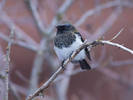search
classification
|
basic information
|
video
|
reports |
Blue-capped Redstart
Phoenicurus caeruleocephalus (Vigors, 1831)

|
 spring male
|
|
|
2021-03-25
Jalal-abad region |
© Philippe Campeau
|
|
Description
The Blue-capped Redstart is one only redstart in Kazakhstan having not reddish but black tail. The adult male has the black back, tail, head and breast; the abdomen and speculum on the wing are white, the crown is grayish-blue. After summer (in August) molting males have coloring with a greysh-brownish tinge, there isn't the contrast on coloring of the back and the crown. The female is greysh-brown; the tail is dark-brown. The uppertail is chestnut-rufous. Juveniles have the dark, grayish-brown with the light spots color, the dark-grey tail and the reddish-rufous uppertail.
Biology
The Blue-capped Redstart is common, in places rare breeding migrant. It inhabits the old spruce forests with the plenty of wind fallen branches and small rocks (or large stones) at 1400-2700 m in Zailiyskiy Alatau; and the height juniper forests with some rocks at 1700-2000 m in Talasskiy Alatau. On migration it visits deciduous and riparian forests, gardens, groves, forest-belts and bush thickets. It appears at low altitude in March – early April, at Chokpak Pass single Blue-capped Redstarts were ringed on April 1-8; to breeding places appears in mid-April. It breeds in separate pairs at 100-250 m one from another. Nest is built during 5-12 days by female only (male escorts her) on the ground under the spruce roots, stones or tussocks, in the precipices cavities, cliff cracks or between the stones; nest is from the moss, thin twigs and dry grass and lined with hair and feathers. Clutches of 3-5 light (from bluish-white to beige) rufous tinged eggs is in end April – late July. Only female incubates for 13-15 days. Both parents feed juveniles fledged at 15-17 days old, in early June – mid-August, as exception in early September. In a week after fledge of the juveniles the female begins the new clutch and incubate it, but the male even a week feeds flying juveniles. As a rule two broods reared per year; the repeated breeding after losing of the first nest is common. In August both young and adults mew. Autumn dispersal starts in the end August, majority of the birds migrates in end September. On Chokpak Pass single birds were ringed on 17-25 October in 2000-2001. Latest migrants recorded in late November.
References
Э.И.Гаврилов. "Фауна и распространение птиц Казахстана". Алматы, 1999. Gavrilov E. I., Gavrilov A. E. "The Birds of Kazakhstan". Almaty, 2005. А.Ф.Ковшарь "Певчие птицы". Алма-Ата, "Кайнар", 1983.







